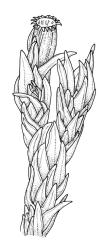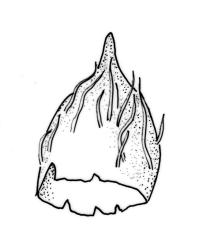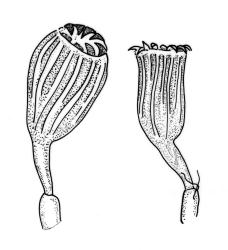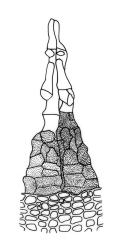- = Orthotrichum calcareum R.Br.bis, Trans. & Proc. New Zealand Inst. 27: 427 (1895)
- = Orthotrichum ornatum R.Br.bis, Trans. & Proc. New Zealand Inst. 27: 426 (1895)
- = Orthotrichum pulvinatum R.Br.bis, Trans. & Proc. New Zealand Inst. 27: 426 (1895)
- = Orthotrichum oamaruanum R.Br.bis, Trans. & Proc. New Zealand Inst. 35: 332 (1903)
- = Orthotrichum oamaruense R.Br.bis, Trans. & Proc. New Zealand Inst. 35: 332 (1903)
- = Orthotrichum austrocupulatum Dixon & Sainsbury, J. Bot. 71: 244 (1933) – as austro-cupulatum
- ≡ Orthotrichum cupulatum var. austrocupulatum (Dixon & Sainsbury) Lewinsky, J. Hattori Bot. Lab. 56: 433 (1984) – as austro-cupulatum
Plants mostly 12–20 mm, occasionally shorter, forming loose tufts or cushions, green, blue-green, olive-green or brown above, brown-black below. Stems moderately branched by innovation, with rhizoids variably developed. Leaves erect-appressed and sometimes slightly contorted when dry, spreading when moist, ± glaucous, lanceolate to ovate-lanceolate, acute, entire (or slightly dentate near apex when young), sometimes decurrent, narrowly or broadly recurved on one or both sides, (2.0–)2.3–3.2 × 0.5–0.8(–1.0) mm (including perichaetial); upper laminal cells thin- or thick-walled, isodiametric or nearly so, (5–)8–13 × 8–13 µm, with 2–3 low and usually unbranched papillae per cell; basal laminal cells rectangular or almost quadrangular, (19–)32–64 × 9.5–16 µm, thin-walled, lacking pores. Costa as per genus. Gemmae absent.
Gonioautoicous. Perichaetial leaves ± larger than vegetative. Perigonia gemmiform. Setae straight or ± curved, 0.6–1.5(–2.0) mm (excluding vaginula); capsules immersed-emergent and erect or exserted and bent downwards when dry, ovoid-urceolate or cylindric-ovoid, yellow-brown, with 8 long furrows usually alternating with 8 shorter ones and somewhat constricted below the mouth when dry, faintly ribbed when moist, 1 per perichaetium; exothecial cells differentiated into alternate bands of thick-walled and thin-walled cells; the 8 thick-walled bands c. 3 cells wide and with thickened longitudinal walls; the thin-walled bands corresponding to the furrows of dry capsules; stomata immersed, slightly or almost completely covered by the subsidiary cells, restricted to the central and lower part of the capsule. Peristome single or double; exostome teeth 16, orange-yellow, erect-spreading when dry, covered by a mixture of vertical, ± vermicular lines and papillae (near the base the lines ± horizontally orientated); preperistome present or absent, if present sometimes covering the entire surface of the teeth; endostome variably developed, either absent, highly reduced, or of hyaline and finely papillose segments which are ½ to equal the exostome teeth. Calyptra conic or conic-oblong, yellow with red-brown apex, plicate, slightly split near the base, hairy (the hairs strongly papillose, yellowish, and reaching to top of calyptra). Spores globose, 18–22.5 µm, coarsely papillose.
Lewinsky 1984, figs 27 & 30 (variously cited); Smith 2004, fig. 224, 1–7.
Orthotrichum cupulatum is sometimes confused with Zygodon menziesii, which also commonly grows on limestone. The dry plants of O. cupulatum are dull and often faintly glaucous with nearly straight leaves in contrast to the distinctively lustrous, non-glaucous plants with often spirally twisted leaves of Z. menziesii. Further distinction is provided by the usually distinctly obliquely ranked and smooth upper laminal cells (giving a KOH positive yellow reaction) and the presence of fusiform axillary gemmae in Z. menziesii.
NI: N Auckland (Hikurangi Limestone Scenic Reserve, Waro Limestone Scenic Reserve), S Auckland (Piopio, near Tawarau River), Gisborne (Hopuruahine River, Panekire Range, Maungapōhatu), Hawke’s Bay (near Waipukurau, Tukituki River), Wellington (NW Ruahine Range); SI: Nelson, Marlborough (Blue Duck Scenic Reserve, Leatham River), Canterbury (Broken River Basin), Otago (Cripple Range, Crown Range, Motatapu Valley), Southland (Takahē Valley). While scattered in distribution in N.Z., this is a common species in the calcareous ranges of Nelson L.D. and in the Broken River Basin; a large proportion of herbarium specimens come from those areas.
Nearly cosmopolitan. Lewinsky (1984) recorded this species from a few localities in Australia, including N.S.W., A.C.T., and Vic. while Smith (2004) outlined its world distribution to include Europe, Iceland, Caucasus, Turkey, Cyprus, northern Asia, Macaronesia, North Africa, North America, Australia, and N.Z.
Mostly restricted to calcareous rocks, although a few collections from schist in Otago L.D. have been confirmed. Rarely collected from concrete (as at Clifton). On the North I. ranging from low elevations to c. 900 m (Panekire Range); on the South I. from near sea level (Clifton, Nelson L.D.) to at least 1830 m (Mt Owen, Nelson L.D.). Lewinsky considered this species to extend to elevations of c. 2050 m. The only Hawke’s Bay L.D. specimens seen are two poorly localised 19th century collections by W. Colenso.
In addition to the taxonomic synonyms listed above, Lewinsky (1984) tentatively included the Robert Brown names O. oamaruense R.Br.bis. and O. oamaruanum R.Br.bis., (both published in Trans. & Proc. New Zealand Inst. 35: 332, 1903) as probable synonyms. Lewinsky presumed the types of these two names to be lost.
Orthotrichum cupulatum has a wide but scattered distribution in N.Z. It is variable here, as it is in other parts of its very wide range. It varies in size, growth form, leaf shape, and degree of leaf cell papillosity, length of seta and ornamentation of the exostome teeth. An endostome may or may not be present, and the vaginula and calyptra vary in hairiness. N.Z. plants, like European ones, mostly have simple leaf papillae.
Lewinsky’s (1984) recognition of the allegedly endemic var. austro-cupulatum is not accepted here, due to a large number of morphological intermediates. Considerable variability of seta length occurs in single herbarium specimens. One of the specimens (G.O.K. Sainsbury 4081) cited by Lewinsky (1984, p. 436) as representative of the variety has short setae (c. 0.6 mm) and hence does not agree with one of Lewinsky’s primary criteria for this variety. Other specimens with short (c. 0.8 mm) setae and ± erect capsules have well-developed endostomal segments c. ⅔ the exostome height, thus further blurring the distinction. The species is particularly variable in the Broken River Basin.
For those wishing to apply the infraspecific concepts of Lewinsky, her concept of var. austro-cupulatum includes smaller, darker, and more compact plants with more nearly cylindric capsules exserted on a bent seta, and with a well-developed endostome.










